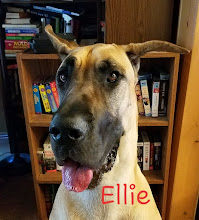
Teddy says: "Now give me a cookie!"
To give you an idea of what a Rally course is like, here is the map of the course we had today in the Novice class:
The first exercise consisted of the dog & handler weaving in & out of 4 cones. The second exercise requires the dog to drop into a Down next to the handler - the handler gives this command while the team is still moving forward. Next, the handler calls the dog to sit in Front. Then the dog moves around behind the handler and sits in Heel position at the handler's left side.
The 4th sign is for a Left turn. The exercise after that requires the team to make a small circle to their Left. Exercise #6 is a 270 degree turn - it's called a "270 Right Turn" because the team turns to their Right as they make this turn... but it's actually a Left turn.
Exercise #7 requires the handler to call the dog to sit in Front, then move to the handler's Left side to get back into Heel position. But this time, the handler begins moving forward before the dog sits. Exercise #8 is a Spiral Left - meaning the team turns toward their Left, into the dog. Spirals in Rally are a series of concentric ovals - you do the largest one first. Exercise #9 is the Left About Turn - the handler makes a quick Left turn toward the dog, and the dog meanwhile circles behind the handler and winds up back on the Left side. I really enjoy this particular turn, but it can be confusing for some people to learn. It reminds me of a square dancing move! (I'm probably sounding really old here - do they still teach square dancing in elementary schools?? Somehow I think not! But they did when I was there.)
The next exercise calls for a Fast pace - the handler should break into a trot, and the dog should keep up. At the "Normal Pace" sign, the team slows to their normal (should be brisk) walking pace. Exercise #12 is a Right About Turn - the team makes a tight 180 degree turn to the right. The last exercise sign calls for a Slow pace - the handler should noticeably slow down and again, the dog should adjust to stay in position. I tell my students that the Fast should be the sort of quick trot you'd do to catch an elevator. The Slow should be a window-shopping stroll, and the "Normal" pace should be a brisk but comfortable walk. As the team passes the Finish sign, they're done!
Through all the exercises on a Novice course like this, the handler is free to talk to the dog, give multiple commands and/or hand signals, even pat his/her leg or clap hands. The dog is on lead throughout. It's a lot of fun, and like I said above, not too difficult. Hopefully as you are reading this you are thinking that maybe this is something you could do with YOUR dog!!









No comments:
Post a Comment